Aloha from Maui!
The Valley Isle and the second largest island of Hawaii
Sunny greetings from the tropical rainforests of Maui! Maui, the Valley Isle, is the so-called "Valley Island". But more about where her nickname comes from later ... First of all, we would like to show where Maui, an island of the archipelago Hawaii lies: On the Hawaii map, the eight main islands line up like pearls on a necklace. Maui lies between Oahu, the island with the most inhabitants, and Big Islandthe Hawaii island with the largest area. Both islands are less than an hour away by plane, so island hopping is possible even with a small amount of time.
360° panorama: view over Kīhei (Maui)
Maui (Hawaii) Shortfacts:
Maui is the second largest island of Hawaii and introduces itself in this article. We have summarized the most important information for you:
- Current time:
- Area: 1883 km²
- Inhabitants: +140.000
- Tourists in 2017: 2.740.000.
- Of these, 21,000 came from Germany!
- They spent an average of 8 days on Maui.
- Tourists per day:
- Mathematically, there are about 60,050 tourists on Maui every day.
- 106 persons per km² are thus on the island including inhabitants.
- Climate on Maui:
- Daytime temperature: 27.6° to 31.8
- Rainy days per month: 10-14 days
- Sunshine hours in a month: 166 - 229 hours - then you walk in the moonlight at the pacific ocean along to the accommodation. For you alone, you are also on a boat trip.

By loading the map, you accept Google's privacy policy.
Learn more
Location of Maui Island on Hawaii map
But why do the inhabitants of Maui call their island the Valley Island? Like all Hawaii islands, this Pacific island owes its existence to volcanic activity. Many thousands of years ago, volcanoes erupted deep under the sea and Maui emerged in its present form. You can still discover two of these volcanoes on your trip: The West Maui Volcano and the Haleakala. The larger of the two is Haleakala with 3055 meters - hike up there and enjoy the view over Maui. This will be an unforgettable and unique experience on your Maui trip. It is also recommended to take a hike in Polipoli State Park, a natural reservoir on the Haleakala slope, about 10 miles from Kula. At the higher elevations, it is immediately a few degrees cooler than on the beaches and in the south of the island.
For the price of 30$ per car, you have access to the National Park, the volcano area and the Kipahulu District for 3 days. You can explore the area on different hikes. The Pipiwai Trail in the Kipahulu area, for example, is formed by the Oheo Pools and partly goes through a Bamboo Forest and the Waimoku Falls, is an extremely popular trail. You should include it in your plan!
Maui is a volcanic island, but do not worry, the volcanoes do not erupt today. A bridge of magma has formed between them over time. This piece of land connects the parts of the island. This has created a valley between the two mountains! And exactly this valley gives Maui the nickname "Valley Island".
Top sights on Maui
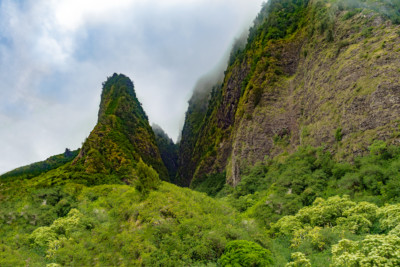
Īao Valley State Monument (State Park)
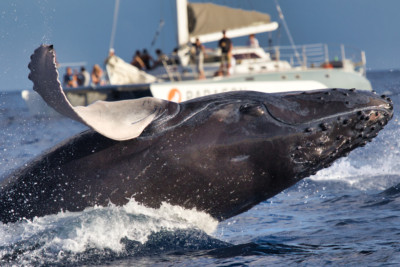
Auau Channel | Lahaina Roads (Whale Watching)
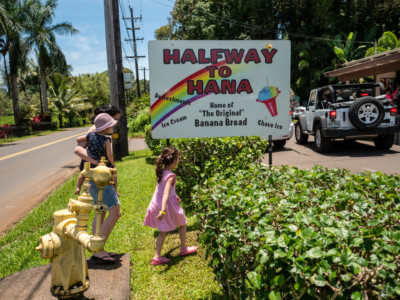
Road to Hāna
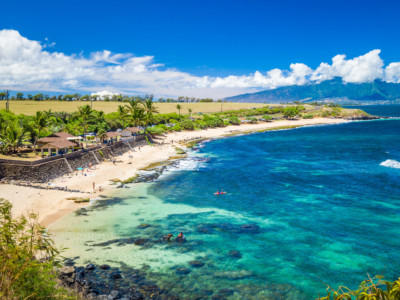
Hoʻokipa Beach Park
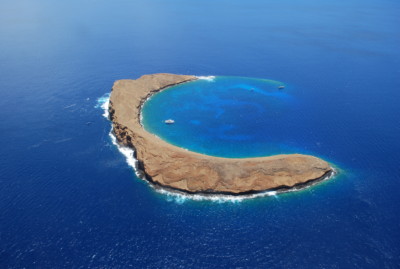
Molokini Crater
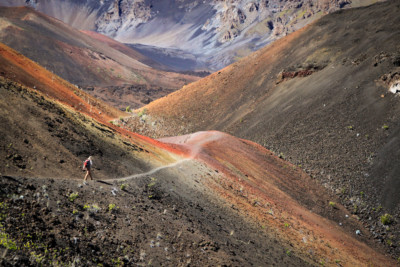
Haleakalā Crater & Haleakalā National Park

Īao Valley State Monument (State Park)

Auau Channel | Lahaina Roads (Whale Watching)

Road to Hāna

Hoʻokipa Beach Park

Molokini Crater

Haleakalā Crater & Haleakalā National Park
Information about Maui's inhabitants
Maui is very popular with tourists - especially sun worshippers from the US mainland and Canada. So it's no wonder that the residents focus on Tourism. This is true for the whole of Hawaii. Especially in the beach area around Lahaina and Kapalua and between Wailea and Kihei, most of the inhabitants live from the tourism industry. They are employed in a large hotel or resort on the coast, work in the numerous restaurants or help you discover the many highlights on Maui. Employees are also needed year-round at the airport, rental car companies, or at golf courses and national parks.
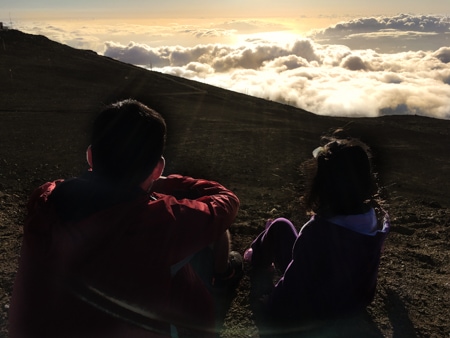
However, there is more to Hawaii's second-largest island than tourism and various visitor centres: the volcanoes have given the land extremely fertile soil, which the residents of Maui use for agriculture.
In the hinterland of the island, the area between Haleakala and the West Maui volcano, there are great climatic conditions for Pineapple cultivation - the tropical fruit for which the islands are known. Sugar cane cultivation has also made up a large part of Maui's agriculture.
However, the era of sugar cane cultivation and plantation workers came to an end in December 2016. The growing and especially cheaper competition from China, Pakistan and Thailand, as well as the stop of subsidies by the US government caused this industry to collapse. The last active sugar cane factory near Paia was closed in 2016. In a museum, however, you can learn about the history of cultivation and travel "back" in time.
Still today, coffee and wine is grown on Maui. At Kaanapali, you can even watch your future cup of coffee grow. Hawaii is the only coffee-growing region among the Western industrialized nations and thus has an absolutely unique selling point. The finest and most valuable coffee, however, comes from the neighboring Big Island - the famous Kona Coffee.
And yes, there is also wine in Hawaii. The slopes of Haleakala are ideal for growing wine. In addition to sparkling wine, white wine and red wine, pineapple wine and wine from the lilikoi (passion fruit) that grows there are also produced for example.
The area around Kipahulu is also exciting. There, the people live somewhat remotely and more originally. The farming community is not connected to the water supply and electricity. The residents in the Kipahulu district get their water from the streams. This part of the island used to be more populated but since the 70s, more people moved to the northwest coast to the Lahaina area due to whaling.
But most people on Maui move with the times and are partly ahead of it: The Maui High Performance Computing Center in Kihei develops high-performance computers. At the top of Haleakala are also important U.S. telescope systems that researchers use to observe space to accompany scientific work and studies.
No matter when, Maui is worth a visit any time of the year!
The Hawaiians are accompanied by the Weather which spoils them all year round. On Maui, it is nice and warm all year round and never too hot: In summer the thermometer reaches up to 33 degrees and in winter it does not fall under 18 degrees. It is especially warm on the beaches and in the south, whereas on the north coast there is more precipitation and sometimes a somewhat cooler wind blows. But it is never really cold.
On the northwest coast, where the tourist centres are located, it is also drier than inland. In winter from November to March, it rains a little more on Maui. However, it gets really chilly only on top of the two mountains. So for a hike up there you better wear something warmer. Especially for sunrises and sunsets at Haleakala, you definitely need a jacket, closed shoes and long pants. On Maui, winter is the best time of year for experienced surfers, windsurfers and kite surfers; and for those who like to get up close and personal with whale watching, a whale Watch Tour in Lahaina to Auau Channel is a must.
With such a dreamlike climate, it is not surprising that there are more than two million tourists per year on Maui. At any time of the year, there is much to discover on Maui from beaches to tropical forests to history. surfing has tradition in Hawaii - also on Maui. And the island is not named after the Demigod Maui for nothing. Maui is considered the inventor of surfing: according to legend, he reached the sun with his big oar in just one stroke. Especially the surf spot Jaws at Peahi Beach is known among surfers from all over the world, because the waves here can get enormously high in winter. Jaws was often a spot for international Big wave surf competitions in the past and has a high popularity in the scene.
Besides surfing, Maui's beaches also offer plenty of opportunities to try other water sports (like canoeing, kayaking, scuba diving, snorkeling, stand-up paddling and more) in the turquoise waters of the ocean. The best way to do this is to check out our Maui Sights. We describe each beach and why it is particularly popular and known. You will find valuable tips, addresses and much more.
But also simply the underwater world on site and the green sea turtles (called Honu in the Hawaiian language) are of great popularity among visitors to the Islands. Maluaka Beach (Turtle Town) is home to many of these fascinating sea creatures. For this reason, Maluaka Beach also bears the secondary name Turtle Town 😉 .
Excursion boats to the crescent Molokini Crater often include a stop at Maluaka Beach to see the turtles. In order to observe the animals under water while swimming and eating, the snorkel should not be missing in your luggage. Green sea turtles on Maui like to feed on Anapanapa, a special red algae that grows there.
Most vacationers check into the visitor centres and hotels around Lahaina, Kapalua, Kihei, Kaanapali and Wailea. There is a hotel or resort for everyone here. Kaanapali Beach for example, was named America's best beach years ago, and not without reason. Three miles of white beach and turquoise, clear waters of Kaanapali attract tourists to this part of the island. This is where you will find some of the more upscale resorts. Nevertheless, the beaches are accessible to all, and not only for hotel guests. Besides luxurious accommodations - these 5 star hotels - there are also smaller accommodations and apartments settled along the coast. However, it can happen quickly that the hotels and accommodations are fully booked in summer. Therefore, it is best to book as early as possible. If you need help, feel free to write us.

The capital Kahului is home to the island's airport: The Maui Airport. You can travel from Oahu, Kauai and the other Hawaiian Islands. But the island is also accessible internationally: The airlines offer flights from the major airports in the U.S. and Canada. For example, there are flights from San Francisco, Los Angeles, Chicago or Toronto - it is often the stopover for your Hawaii trip.
While the neighboring island of Oahu is particularly popular with Japanese tourists, Maui attracts tourists from North America. We like both Hawaiian Islands 😉 Each has its charm.
Our beloved Maui - so incredibly green and versatile!
It does not get too cold anywhere on Maui and you can always have a relaxing and exciting trip. But you should know one thing: Each part of the island has its own unique character - and a beach is always just a few miles away. Therefore we would like to give you some information about the different parts of the island and our favourite regions on Maui.
West Maui: Luxury vacation, dream beaches and Lahaina
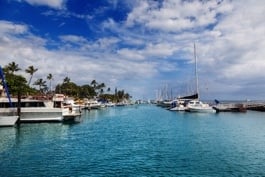
If you look at the map of Valley Isle, you'll find a wide selection of hotels and resorts on the northwest coast. These are located near fine beaches, where usually the best bathing weather prevails. Between the cities Lahaina, Kaanapali and Kapalua,the connections are very good and you certainly won't get bored: heading north, you can try your hand at surfing. The Honolua Bay, a 20 minute drive north of Lahaina, is a popular spot for diving and surfing in the summer. The clear water is also very inviting for snorkelling. In winter, the waves around Honolua are quite high and strong, and therefore only recommended for experienced surfers. The viewpoint above the cliffs allows watching the pros in the waves from a safe distance. And do as the locals do: The back of a van can serve as a makeshift picnic table 😉.
Golfers will also get their money's worth: against the gorgeous backdrop of the rainforests, you will find many golf courses. Unfortunately, the areas of the golf courses on Maui take up too much space which means these natural areas are missing. If nature connection and sustainability is important to you, leave the golf on Maui alone 😉
The city of the merciless sun, Lahaina, was once an important whaling town on Maui. The Pacific Whale Foundation offers some whale-watching tours departing in winter. The whales, the largest mammals in the world, appear from December to April. Lahaina is also home to the Whalers Village Museum, a visitor center for those interested in the history of whaling.
Even King Kamehameha I once discovered the beautiful location of the romantic town of Lahaina and settled here with his devotees of that time. In Lahaina, you can wander endlessly through the small boutiques but you can also go on a journey into the past. There are exciting museums and sights - end the day off in the historic harbour pubs.
East to North Maui: The Hana Highway with waterfalls and breathtaking views
The centre for surfers is the small town of Paia - just behind the island's capital Kahului. There are competitions in which athletes from all over the world compete in surfing every year. The reason is the meter-high waves, with which the east coast of Maui lures. Jaws or Peahi Beach is one of the world-famous surf spots on the island of Maui. Between miles 13 and 14 of the Hana Highway, you will find this beach where the absolute pros show their skills in winter while you watch them from the picnic table. Ho'okipa Beach, just behind Paia, is also known for its great surfing conditions. You will find more about Surfing in Hawaii in our Hawaii Magazine. Whether you want to try your hand at surfing or not, Paia with its wooden houses and diverse cafes, restaurants and bars with live music is not to be missed.
On the eastern part of the northern tip of Maui is the Nakalele Blowhole,a popular excursion site for tourists. In Poelua Bay, there is the geyser-like blowhole, through which, depending on the waves and tides, the water masses shoot up. At the Nakalele Blowhole, however, visitors are advised to be careful. The water can shoot up to 100 feet into the air and a certain safe distance must be kept from this natural spectacle.
The Road to Hana - a milestone on your Maui journey
Directly behind the surfer's paradise, Paia begins the 84-kilometer long and winding Road to Hana. Rent a car from one of the rental car companies and go on a day-long journey of discovery - keep following the narrow coastal road. The 65-mile road takes you over more than 50 bridges, some of which are single-laned and feature waterfalls unlike any you've seen. Along the route, you will find a few trails that bring you closer to Maui's nature and plenty of viewpoints of the ocean. For refreshment, you can swim in the small pools on the Hana road in the rainforest. Since the Hana Highway is a bit elevated, you have beautiful views over Maui and the ocean - the perfect panorama for your photos or a postcard to send home.
The numerous curves and serpentines make the drive an adventure in itself. The road is the destination! The Road to Hana offers the opportunity to stop every few kilometres.
To name a few of the milestones... there's the Koʻolau Forest Reserve, a national park with picnic areas and hiking opportunities, the Ho'okipa Beach Park, a surfing spot and popular place with numerous turtles, the Twin Falls, the Maui Garden of Eden, a botanical garden in the middle of the green rainforest, the Nahiku Marketplace, a great place to have lunch and buy souvenirs, the Red Sand Beach (Kaihalulu Beach)where you can snorkel wonderfully, the Black Sand Beach (Wai'anapanapa State Park), Kipahulu, the fascinating Seven Sacred Pools (also known as Pools of Oheo) - it's worth it!
Unfortunately, there are very few parking spaces on the route and especially at the waterfalls. At the Twin Falls, for example, you have to pay for parking. At other smaller waterfalls such as the Hanawi Falls there are parking bays available. Sometimes it is worth waiting for a bit until something becomes available, but sometimes it is not possible to stop and you may have to stop here on the way back.
If you want to learn more about the versatility and the sights of the legendary "Road to Hana", then head this way to our detailed Road to Hana Guide with Map.
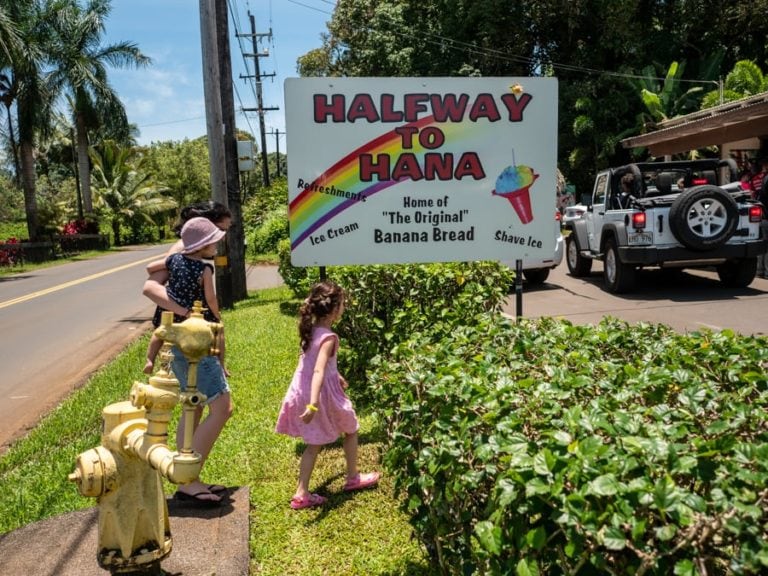
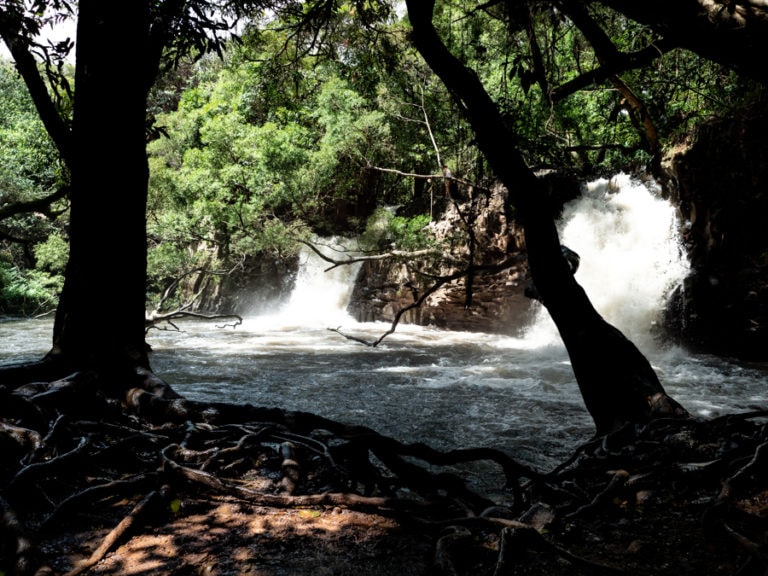
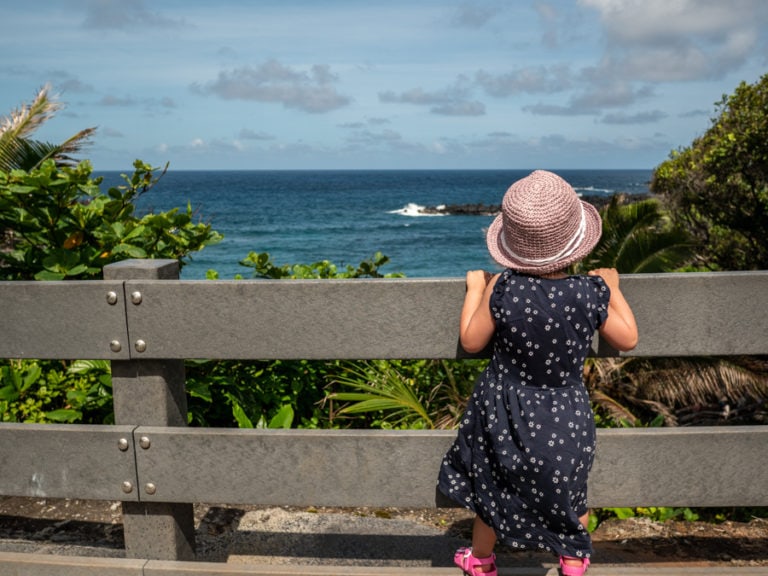
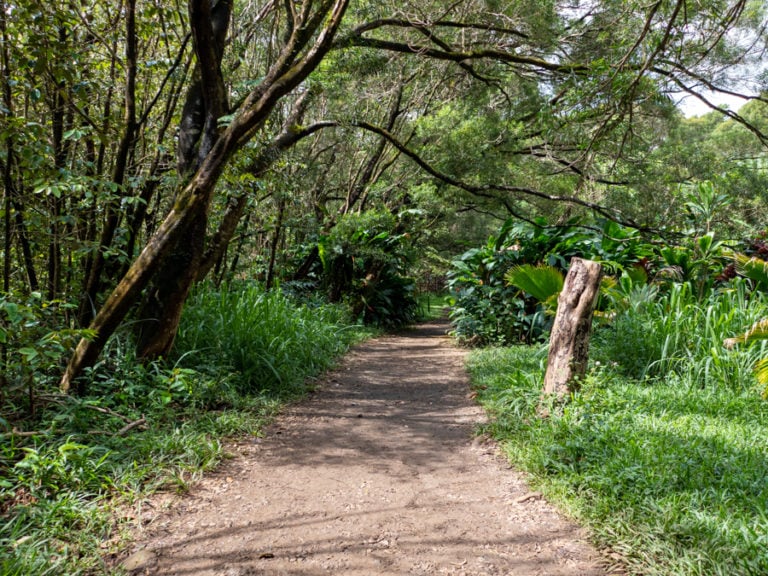
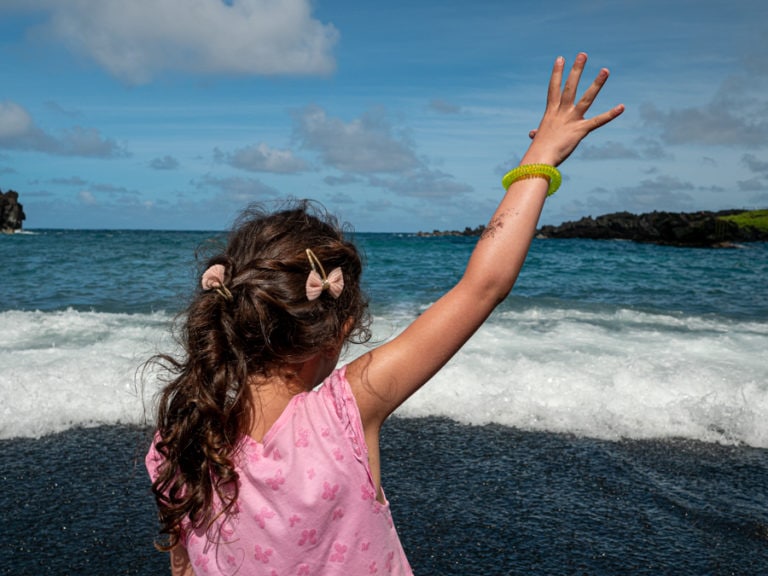
The heart of Maui with Kahului and Haleakala National Park
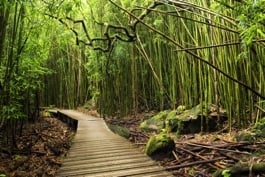
If you fly to the green island of Maui, you will probably arrive in Kahului - the capital of Maui is home to the airport (airport code OGG) and a port for container and cruise ships. You can stroll through the shopping centers in Kahului or learn more about the culture: In the capital, you will find several museums, such as the Sugar Museum. Sugar cane had great importance in the islands of Hawaii and the museum offers you interesting information about the history of the sweet commodity. The economic activities in Maui are concentrated on Kahului and to the nearby Wailuku. Just behind Wailuku begins the Iao Valley - also called the Needle Crater. Take a short trip into the valley and discover where it got its name: In the middle of the valley stands the Iao Needle - this pointed, needle-shaped rock is 370 meters high and densely overgrown. You can see the colorful plants and gentle streams during a walk in the Kepaniwai County Park From Wailuku and Kahului you can reach the top of Maui by rental car. At the top at an altitude of over 3000 meters, the Haleakala National Park is situated. For the 80 km long route, you need to plan about 1.5 to 2 hours. The view and the interplay of all the colours make you forget the drive up: The underground lava shimmers sometimes red, sometimes even green, blue or yellow. The volcano park offers a lot of wonderful and unique photo motifs for your vacation memories.
Enjoy the variety of rare flowers and shrubs on the trails through the volcanic crater and on the crater rim. On Maui, you can visit Puʻu Kukui, the highest mountain in West Maui, as well as Haleakala, which is formed by theeeeee Silver sword, a silver shimmering plant which is threatened with extinctionThe silversword grows nowhere else in the world, so it is a real rarity. If you want to learn more about the flora and fauna of Haleakala National Park, you can find a lot of information at the visitor centre there.
On your trip to Haleakala, be sure to stop in Makawao, a small cowboy town in the Upcountry. Cute cafes, boutiques and stores invite you to stay here. There is also a small museum that informs about the history of the place.
Off to snorkel in sunny South Maui
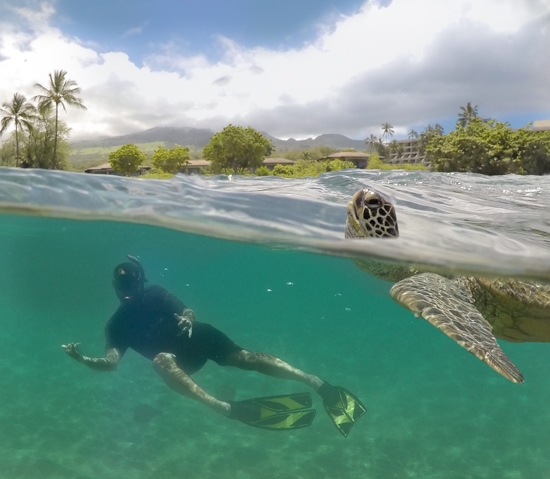
While the east and north of Maui can be a bit rainy in the winter, only little of that arrives on the south coast. The south of Maui is so sunny and dry like hardly any other region in Hawaii and is one of the areas with the least rainfall. No wonder tourists like to spend their vacations here. Fine beaches, gentle waves and sheltered bays - in the shallow water off Kihei you can relax and swim with the family or discover the Pacific Ocean while snorkelling. Kihei is particularly family-friendly: large apartments and hotels as well as recreational activities for young and old are abundant. Want to find out more about vacationing with the family? Feel free to contact us and find out more in our magazine articles about Hawaii with children.
In the south of Maui, there is also the small port city Maalaea located. Not only fishing boats leave from here but also many boat tours, for example to the Molokini Crater and Turtle Town (Maluaka Beach). It is best to register online before. If you're lucky, you'll witness the humpback whales off the coast: From December until April, the whales migrate along the coast. Maalalea Bay also invites you to go diving. Book your diving experience at one of the many schools around Wailea - the underwater world off Molokini is especially popular. A small, crescent-shaped crater island at the Makena State Park: Here you can swim and snorkel together with peaceful sea turtles .
The destination for all romantics - Maui for lovers
Whether for adventurers, beach lovers, culture enthusiasts or families - the dream vacation is waiting for everyone on Maui. And: Maui can also be romantic. The island is a popular honeymoon and wedding destination for many couples.
A dreamlike scenery is offered for your wedding and there is also plenty of romance for the unforgettable honeymoon on Maui. Is there a more beautiful place to get married than a fine sandy beach, turquoise blue water, colorful and magnificent nature, palm trees and sun guaranteed? Nature with its overgrown volcanoes provides the perfect background for this occasion. West Maui is especially popular for beach weddings.
Do you want a little luxury for the occasion? The elegant resorts in Wailea offer you the perfect place to get married - right on the beach and with a fine menu - the most beautiful day of your life will be perfect. You are not sure yet? You have professional wedding planner and photographers by your side. Whether on our website or on-site - let the professionals advise you so that your wedding becomes your dream wedding. Romantic hours are guaranteed on Maui!
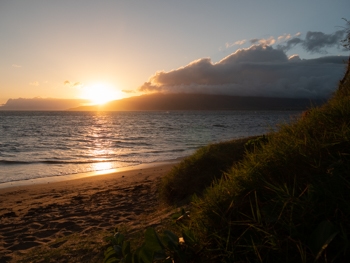
After the wedding, you and your partner can enjoy a relaxing time together. You will find the fitting accommodation and many activities for your romantic time. Depending on your needs, you can choose from a bed and breakfast to a 5-star hotel. Start the day with a dreamlike sunrise at the crater rim of Haleakala volcano and walk one of the numerous trails in Polipoli State Park or at Haleakala Crater. Afterwards, discover the curved Road to Hana with all its hairpin curves, which lead along numerous waterfalls. You can then have lunch in one of the typical Hawaiian restaurants. End the eventful day in one of the quiet bays - you can take a walk in the moonlight along the Pacific Ocean back to the accommodation or book a boat trip.
Maui travel guide questions: Everything so far so (un)clear? 😉
In our travel guide to Valley Isle, we have tried to conclude the most important information for you. And if you are missing something - write to us!
You still have questions?
Your questions, answered by us:
Maui is located in the middle of the Pacific Ocean and with 1883 km², it is the second largest island of the archipelago of Hawaii. The Hawaiian islands form the 50th state of the USA since 1959 and can be reached in about 6 hours by plane from California. The distance to the US mainland is just under 4000 km.
Maui is the largest island of Maui County, which combines the islands of Maui, Molokai and Kahoolawe.
Geographically, however, Hawaii is not assigned to the American continent. It is a part of Polynesia. The chain of islands forms the northern tip of the so-called Polynesian Triangle and it belongs to the South Sea Islands.
The largest airport on Maui is Kahului Airport (OGG). It is served from Oahu's capital Honolulu.
Direct flights from the US mainland depart, for example, from cities such as Los Angelos (LAX), Seattle (SEA), Anchorage (ANC) in Alaska or even Vancouver (YVR) in Canada.
In addition to Kahului Airport, there are two other small airports, Kapalua Airport (JHM) in West Maui and Hana Airport (HNM) in East Maui.
Maui is the second largest island of the Hawaiian archipelago and is also called Valley Island, which translates as "island of valleys".
Due to erosion, a shallow land bridge (isthmus) was formed between Mauna Kahalawai, the West Maui Mountains, and Haleakalā, Maui's highest mountain and also a massive shield volcano, which occupies 75% of the island's area.
This land bridge looks like a valley from the mountainous region, from which the island got its name Valley Island.
The island of Maui owes its name to Polynesian mythology.
According to the Maori (indigenous people of New Zealand), there was a demigod named Maui, also known as Māui-tikitiki, who was distinguished by his heroic deeds and acumen. It is said that he once defeated the sun or stole the fire for the people.
Hawaiian mythology, which Hollywood blockbusters also like to use, also features the demigod Maui, to whom the island owes its name. According to legend, Maui was able to transform into any animal.
Maui, Hawaii's second largest island, has two official languages: Hawaiian and English.
The Hawaiian or Hawaiian language (proper name: ʻŌlelo Hawaiʻi) is the language of the Polynesian natives of the island archipelago.
There is a third language spoken on the islands, but it is not nearly as well known. Hawaii Creole English or Hawaii Pidgin English is a creole language based on English and incorporating loanwords from Hawaiian and several other European and Asian languages.
